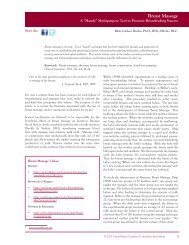Official Journal of the United States Lactation ... - Clinical Lactation
Official Journal of the United States Lactation ... - Clinical Lactation
Official Journal of the United States Lactation ... - Clinical Lactation
Create successful ePaper yourself
Turn your PDF publications into a flip-book with our unique Google optimized e-Paper software.
The Nutritional Adequacy <strong>of</strong> Infant Formula<br />
Share this:<br />
George Kent, Ph.D.<br />
Government agencies that regulate infant formula have been concerned about its safety, worrying<br />
about things like contamination with bacteria and insect parts. Questionable formula has been<br />
subject to government-ordered recalls. This attention reinforces people’s confidence that national<br />
governments are ensuring <strong>the</strong> quality <strong>of</strong> infant formula. However, national regulatory agencies<br />
generally just assume that various versions <strong>of</strong> infant formula and o<strong>the</strong>r foods are safe for children<br />
(Kent, 2011).<br />
While many o<strong>the</strong>rs have commented on safety issues relating to infant formula, few have paid<br />
attention to ano<strong>the</strong>r important point. Safety is about ensuring that <strong>the</strong> product does not cause<br />
direct harm—but that is not enough. There are things infant formula is supposed to do. The quality<br />
<strong>of</strong> infant formula depends not only on its safety, but also on its nutritional adequacy.<br />
Keywords: Infant formula, safety, nutritional adequacy, Codex Alimentarius<br />
<strong>Clinical</strong> <strong>Lactation</strong>, 2012, Vol. 3-1, 21-25<br />
The Regulatory Context<br />
At <strong>the</strong> global level, <strong>the</strong> primary agency concerned with<br />
food quality is <strong>the</strong> Codex Alimentarius Commission,<br />
created by <strong>the</strong> Food and Agriculture Organization, and<br />
<strong>the</strong> World Health Organization in 1963. It issues nonbinding<br />
guidelines regarding food composition and<br />
safety. In 1976, at its 11 th session, <strong>the</strong> Codex Alimentarius<br />
Commission issued a Statement on Infant Feeding. It said:<br />
…it is necessary to encourage breastfeeding by<br />
all possible means in order to prevent that <strong>the</strong><br />
decline in breastfeeding, which seems to be actually<br />
occurring, does not lead to artificial methods<br />
<strong>of</strong> infant feeding, which could be inadequate or<br />
could have an adverse effect on <strong>the</strong> health <strong>of</strong> <strong>the</strong><br />
infant (Codex Alimentarius Commission, 1976).<br />
At this session <strong>the</strong> Commission also adopted a Codex<br />
Standard for Infant Formula. The standard, designated<br />
as CODEX STAN 72-1981, includes a list <strong>of</strong> required<br />
ingredients and various required quality-control measures.<br />
In 1983, <strong>the</strong> 15th Session adopted amendments<br />
to <strong>the</strong> sections on Food Additives and Labeling. A fur<strong>the</strong>r<br />
amendment to <strong>the</strong> Labeling section was adopted in<br />
1985 by <strong>the</strong> 16th Session. Amendments to <strong>the</strong> vitamin<br />
D and B12 amounts were adopted by <strong>the</strong> 17th (1986)<br />
and 22nd (1997) sessions respectively (Codex<br />
Alimentarius, 2007).<br />
This core statement <strong>of</strong> <strong>the</strong> required ingredients for<br />
infant formula is generally accepted throughout <strong>the</strong><br />
world. The permitted nutrient ranges allow a variety <strong>of</strong><br />
quite different formulas. The requirements are widely<br />
regarded as a minimum standard. Some countries have<br />
adopted more stringent requirements.<br />
The primary source <strong>of</strong> binding regulations regarding<br />
foods is national governments. In <strong>the</strong> <strong>United</strong> <strong>States</strong>, <strong>the</strong><br />
responsibility for regulating children’s foods, such as<br />
infant formula, is <strong>the</strong> Food and Drug Administration<br />
(FDA), located in <strong>the</strong> U.S. Department <strong>of</strong> Agriculture<br />
(USDA).<br />
The Federal Food, Drug, and Cosmetic Act defines<br />
infant formula in Title 21, Section 321(z) <strong>of</strong> <strong>the</strong> <strong>United</strong><br />
<strong>States</strong> Code. It is:<br />
…..a food that purports to be or is represented<br />
for special dietary use solely as a food for infants<br />
by reason <strong>of</strong> its simulation <strong>of</strong> human milk or its<br />
suitability as a complete or partial substitute for<br />
human milk (21 U.S. Code 321 (z)).<br />
Section 350a <strong>of</strong> <strong>the</strong> act provides specifications regarding<br />
adulteration, quality-factor requirements, manufacturing<br />
regulations, product testing, and record keeping. It<br />
sets out a list <strong>of</strong> required nutrients and <strong>the</strong>ir minimum<br />
and maximum quantities. The list includes protein, fat,<br />
essential fatty acids (only linoleate is in <strong>the</strong> list), fifteen<br />
different vitamins, and eleven different minerals. The<br />
1 Kent@Hawaii.edu<br />
© 2012 <strong>United</strong> <strong>States</strong> <strong>Lactation</strong> Consultant Association 21




